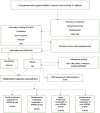Association of white matter hyperintensities with migraine phenotypes and response to treatment
- PMID: 35854172
- PMCID: PMC10505107
- DOI: 10.1007/s13760-022-02015-x
Association of white matter hyperintensities with migraine phenotypes and response to treatment
Abstract
Introduction: White matter hyperintensities (WMHs) are frequently found in migraineurs. However, their clinical significance and correlation to different migraine phenotypes and treatment responses are not well defined. The study aimed to examine the association of WMHs with migraine clinical patterns and treatment response.
Aim of work: We aimed to evaluate the association between WMHs and migraine phenotypes and explore the relationship of WMHs to treatment response.
Methods: Our cross-sectional study formed of 500 migraineurs who sought treatment in Kafr el-sheik university hospital and underwent (3 T) MRI to evaluate WMHs. Different migraine phenotypes were compared between patients with and without WMHs. According to reduced headache pain intensity and frequency, these patients were divided into treatment responder and non-responder groups.
Results: A total of 145 patients (29%) had WMHs. Patients with WMHs were significantly older, had a longer disease duration, and higher attack frequency. Patients who did not respond to acute and maintenance medications had a higher frequency of WMHs and high WMHs Scheltens score. Migraine with Aura and the presence of vomiting and dizziness were predictors for the development of WMHs.
Conclusion: WMHs are more common in migraine with aura. It is more frequent in migraine associated with vomiting and dizziness. WMHs increased with advancing age and more severe disease burden. Poorer response to acute and prophylactic medications was found in patients with WMHs.
Keywords: Migraine phenotypes; Migraine treatment response; WMHs.
© 2022. The Author(s).
Conflict of interest statement
The authors have no conflicts of interest to declare.
Figures
Similar articles
-
Association of white matter hyperintensities with migraine features and prognosis.BMC Neurol. 2018 Jul 2;18(1):93. doi: 10.1186/s12883-018-1096-2. BMC Neurol. 2018. PMID: 29966519 Free PMC article.
-
Risk factors of white matter hyperintensities in migraine patients.BMC Neurol. 2022 Apr 29;22(1):159. doi: 10.1186/s12883-022-02680-8. BMC Neurol. 2022. PMID: 35488255 Free PMC article.
-
A retrospective review of sex differences of white matter hyperintensities in brain MRI of patients with migraine.Headache. 2024 Jun;64(6):612-623. doi: 10.1111/head.14714. Epub 2024 May 24. Headache. 2024. PMID: 38785411
-
Evaluating the relationship between right-to-left shunt and white matter hyperintensities in migraine patients: A systematic review and meta-analysis.Front Neurol. 2022 Aug 18;13:972336. doi: 10.3389/fneur.2022.972336. eCollection 2022. Front Neurol. 2022. PMID: 36061988 Free PMC article.
-
White matter hyperintensities and their subtypes in patients with carotid artery stenosis: a systematic review and meta-analysis.BMJ Open. 2018 May 16;8(5):e020830. doi: 10.1136/bmjopen-2017-020830. BMJ Open. 2018. PMID: 29769255 Free PMC article.
Cited by
-
Ticagrelor Versus Clopidogrel in Acute Large-Vessel Ischemic Stroke: A Randomized Controlled Single-Blinded Trial.CNS Drugs. 2024 May;38(5):387-398. doi: 10.1007/s40263-024-01080-5. Epub 2024 Apr 15. CNS Drugs. 2024. PMID: 38619649 Free PMC article. Clinical Trial.
-
Imaging the brain and vascular reactions to headache treatments: a systematic review.J Headache Pain. 2023 May 24;24(1):58. doi: 10.1186/s10194-023-01590-5. J Headache Pain. 2023. PMID: 37221469 Free PMC article.
-
The effect of lacosamide on calcitonin gene-related peptide serum level in episodic migraine patients: a randomized, controlled trial.Acta Neurol Belg. 2024 Jun;124(3):965-972. doi: 10.1007/s13760-024-02499-9. Epub 2024 Mar 19. Acta Neurol Belg. 2024. PMID: 38502425 Free PMC article. Clinical Trial.
-
TICA-CLOP STUDY: Ticagrelor Versus Clopidogrel in Acute Moderate and Moderate-to-Severe Ischemic Stroke, a Randomized Controlled Multi-Center Trial.CNS Drugs. 2025 Jan;39(1):81-93. doi: 10.1007/s40263-024-01127-7. Epub 2024 Nov 9. CNS Drugs. 2025. PMID: 39520630 Free PMC article. Clinical Trial.
-
Migraine: from pathophysiology to treatment.J Neurol. 2023 Jul;270(7):3654-3666. doi: 10.1007/s00415-023-11706-1. Epub 2023 Apr 8. J Neurol. 2023. PMID: 37029836 Free PMC article. Review.
References
MeSH terms
LinkOut - more resources
Full Text Sources
Medical
Research Materials
Miscellaneous



